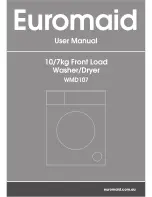
6
Starting Your Washer
1. Measure detergent and pour it into the washer. If desired, add
powdered or liquid color safe bleach. Add extra detergent for
the Super Wash cycle.
Drop a sorted load of clothes loosely into your washer.
■
Load evenly to maintain washer balance. Mix large and
small items.
■
Items should move easily through the wash water.
Overloading can cause poor cleaning.
■
To reduce wrinkling of permanent press clothes and some
synthetic knits, use a large load size to provide more
space (see step 4).
2. (OPTIONAL STEP) Pour measured liquid fabric softener into
the liquid fabric softener dispenser. Softener is added
automatically during the rinse portion of the cycle.
Dilute liquid fabric softener by filling the dispenser with warm
water until liquid reaches the crossbar in the opening.
■
Do not spill or drip any fabric softener on the clothes.
■
Use only liquid fabric softener in this dispenser.
3. Close the washer lid.
4. Turn the LOAD SIZE selector to the correct setting for your
wash load and the type of fabric being washed.
■
Choose a load size that allows the load to move freely for
best fabric care. See "Loading."
■
You may change the load size selection after the washer
has started filling by turning the selector to a different
setting.
5. Set the TEMPERATURE selector to the correct setting for the
type of fabric and soils being washed. Use the warmest water
safe for fabric. Follow garment label instructions.
■
Your washer uses ACCUWASH
™
automatic temperature
control. The ACCUWASH feature maintains a uniform
water temperature by regulating incoming hot and cold
water. This helps eliminate undissolved detergent and
ensures consistent cleaning results. The cold wash is
regulated at approximately 75ºF (24ºC). The warm wash is
maintained at approximately 100ºF (38ºC).
NOTE: Make sure that both hot and cold water faucets
are turned on or the ACCUWASH feature will not work
properly.
NOTE: In wash water temperatures colder than 70ºF
(21ºC), detergents do not dissolve well. Soils can be difficult
to remove. Some fabrics can retain wear wrinkles and have
increased pilling (the formation of small lint-like balls on the
surface of garments).
6. (OPTIONAL STEP) For an additional rinse and spin at the end
of a wash cycle, set the EXTRA RINSE selector to ON.
Fire Hazard
Never place items in the washer that are
dampened with gasoline or other flammable
fluids.
No washer can completely remove oil.
Do not dry anything that has ever had any type of
oil on it (including cooking oils).
Doing so can result in death, explosion, or fire.
WARNING
Electrical Shock Hazard
Plug into a grounded 3 prong outlet.
Failure to follow these instructions can result in
death, fire, or electrical shock.
Do not use an extension cord.
Do not use an adapter.
Do not remove ground prong.
Water Temp
Use For
Hot
111°F (44°C)
or above
Whites and pastels
Heavy and greasy soils
Warm
90°-110°F
(32°-43°C)
Bright colors
Moderate to light soils
Cold
70°-90°F
(21°-32°C)
Colors that bleed or fade
Light soils






























